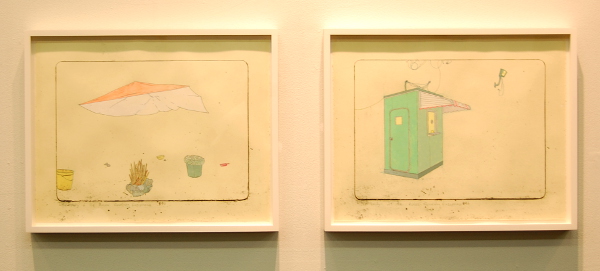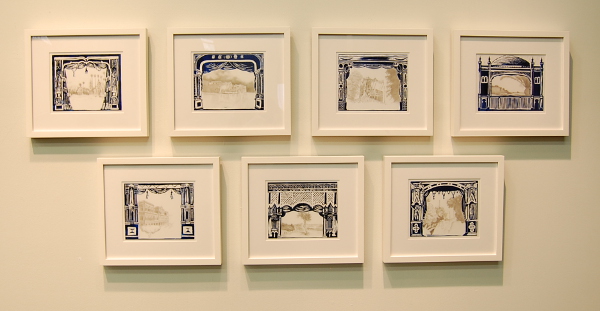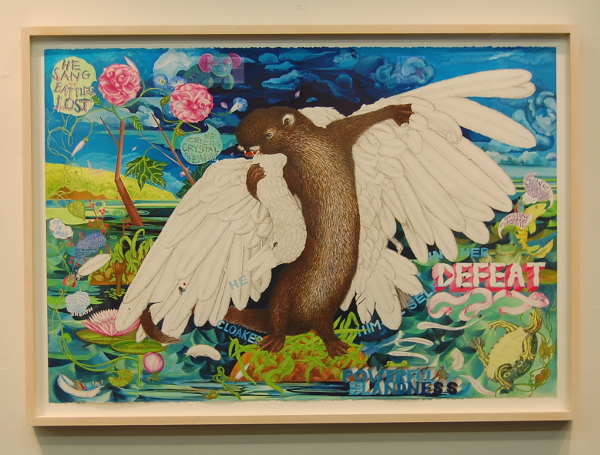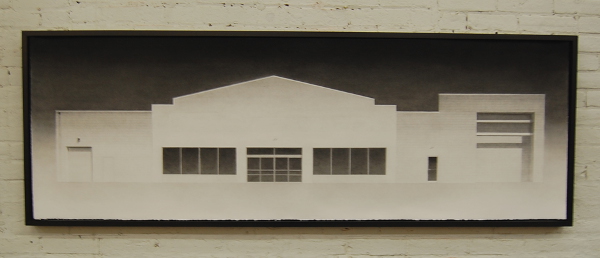
Drawn together in Philadelphia
At Artspace Liberti from now through the end of October, it is possible to get sketchy (literally) with some of Philadelphia’s most cutting edge artists working with one of the oldest, most versatile visual mediums. For “Drawing Now Philadelphia,” curator Sabina Tichindeleanu assembles 14 local artists creating two-dimensional works from graphite, colored pencil, charcoal and ink. By digging into ideas of representation and abstraction, these artists create images that range from austere to ridiculous, while keeping their focus on line and shape most of all. Amze Emmons, “The study of the Rules Governing Exceptions 003” and “The study of the Rules Governing Exceptions 005.”
Two of the more stark and illustrative pieces by Amze Emmons are entitled numbers 003 ad 005 of the series “The study of the Rules Governing Exceptions.” Utilizing a range of materials including graphite, colored pencil, gouache, etching and ink, Emmons constructs sparse locations glowing with washed-out pastel tints. In one we find a sea-foam or mint green structure roughly the size of an outhouse or ticket counter. Its fixtures scream obsolescence but seem in relatively good shape despite their age and potential weathering. A slatted awning reaches out over the front window beside the rounded, rectangular door, while the only other features are twisted wires and a boxy floodlight emerging from an empty background. The other similar drawing depicts only some plastic buckets, an orange tarp with a white underside, and some sticks and stones in the appearance of an unlit fire pit.
Serena Perrone, “Fictive Homelands.”
Exploring other variations on the idea of place is Serena Perrone, who provides a suite of seven woodcut and silverpoint compositions entitled “Fictive Homelands.” Made in shades of grayish silver and dark blue, these almost escapist landscapes are in fact quite cold and barren considering their supposed sentimentality. Each metallic scene is surrounded by printed cobalt colonnades, lattices or the folds of curtains, yet none of the greens of plants or warm colors of sun and sand are present here. Perhaps this coloration is a hint at the fiction portrayed therein, or even lending itself to the qualities of dreams: desaturated, unreal and distant. Either way, these are ghostly images of realistic locations full of majestic architecture and arid or tropical palms, each bestowed with a sense of cautious longing.
Samantha Simpson, “Episode.”
Samantha Simpson takes a very different approach with her ink and watercolor “Episode.” Here we find one of the more lavish works in the show, whose centerpiece happens to be a winged otter (or rather an otter with a swan draped over its shoulders). Around this fuzzy feature there is a cast of other creatures like turtles, fish, frogs, and plants. Textual elements leap from the detailed action composing a poem of dialogue amongst the characters. Some phrases seem to be free standing like “powerful blandness” or “defeat” while others — “he cried crystal tears” and “he sang of battles lost” — emerge as speech bubbles from the surrounding fray. If the movement and chaos here weren’t enough, the words string the viewer along and construct additional images by way of stylized letters that evoke ideas beyond the purely visual elements themselves.
Erin Murray, “Lossiness.”
For a polar opposite to Simpson’s brightness and energy we can turn to “Lossiness” by Erin Murray. The title is some sort of combination of ‘loss,’ ‘loneliness,’ and Stephen Colbert’s ‘truthiness,’ but while its name is linguistically dexterous, the charcoal and graphite drawing itself is more rigid and somber than just about anything in the show; it seems to resist its definitions at face value. In it, a warehouse or commercial building stands immobile without a clear horizon or even surrounding structures. It possesses great visual weight, but remains completely colorless, weighing it down even further with a contextual malaise. Rendered emotionally and actually alone in this drawing, the shadowy storehouse possesses windows that are equally unlit. Despite its crisp exterior, it still maintains a veneer of vacancy and alienation. If it is possible to feel alone in a crowd, then this building represents architecture isolated within a city.
All of these drawings and more will call Artspace Liberti home through October 26.
Artspace Liberti is located at 2424 E. York St., Philadelphia; [email protected]; artspaceliberti.blogspot.com.
Recent Content
-
Artsarticle ·
-
Artsarticle ·
-
Artsarticle ·



